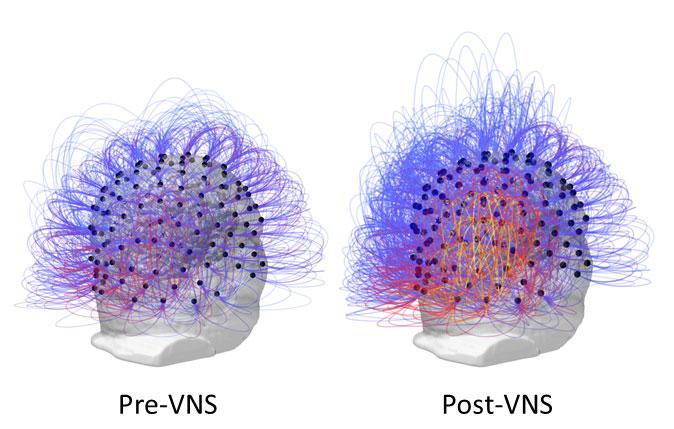Positron emission tomography using a fluorodeoxyglucose radiopharmaceutical, done before the operation (left image) and three months after the vagus nerve stimulation (vagus nerve stimulation, VNS). As you can see, the metabolism increased significantly in the right occipital region, thalamus and striatumA 35-year-old man, who had been in a vegetative state for 15 years as a result of an accident, showed signs of consciousness after neurobiologists implanted a vagus stimulation electrode (vagus nerve stimulation, VNS) into his chest. The results of a unique experiment were
published in the journal
Current Biology . Researchers say that the experiment refutes the widespread opinion that coma lasting more than 12 months becomes irreversible.
The most interesting thing is that this technique is not at all experimental, it will not need to be tested for many years and so on. It is already used in the treatment of epilepsy and depression. Devices for vagal stimulation are commercially available,
including in Russia . And now it turned out that the same relatively old and well-known technique is able to bring a person out of a deep coma.
The vagus nerve connects the brain to many other parts of the body, including the abdominal cavity. It is known that it plays an important role in various processes, including wakefulness and attentiveness. To test the theory that VNS stimulation is able to restore human consciousness, an experiment was conducted, for which scientists chose the most hopeless patient, who was in a vegetative state for 15 years with no signs of improvement.
The experiment was carried out in two groups: the group of scientists was headed by Angela Sirigu from the
Institute of Cognitive Sciences (Lyon, France), and the group of doctors by Dr. Jacques Luauté.
After a month of stimulating the vagus nerve, the patient's attention, mobility and brain activity significantly improved, the report said. The man began to react to simple orders, which was impossible earlier. For example, he was able to follow the eyes of an object and turn his head as directed. The patient's mother reported that he was able to remain conscious for a longer time and not fall asleep when the nurse reads a book to him.
After stimulating VNS, the patient began to demonstrate distinct reactions to "threats". For example, if the researcher's head unexpectedly approached his face, then the patient opened his eyes wider. Thus, it can be stated that after many years of coma, a person has come into a state of minimal consciousness.
Records of brain activity showed significant changes. The encephalogram has significantly increased the signal of theta rhythms (they are important for the difference between the vegetative state and the state of minimal consciousness) in the areas responsible for movement, sensation and awareness (see the illustration above).
 Information exchange between electrodes before and after VNS. Warmer colors (yellow / orange) correspond to an increase in connectivity in the areas of the posterior parietal region
Information exchange between electrodes before and after VNS. Warmer colors (yellow / orange) correspond to an increase in connectivity in the areas of the posterior parietal regionAfter VNS, the functional connectivity of the brain also improved (illustrated).
Positron emission tomogram showed an increase in metabolic activity in both cortical and subcortical areas.
The results of the study were sensational, and this is an understatement. No one would have thought that with the help of existing methods of treatment, but using them for another purpose, one can get a person out of the deepest coma that lasted for more than a decade! If these results are confirmed, it can make a real revolution in neuromedicine, because before the hopeless patients simply disconnected from the apparatus. Now it turns out that “hopeless” patients do not exist at all. “The plasticity of the brain and the recovery of the brain are still possible, even when all hopes are seemingly lost,” says Sirigu.
Now scientists are organizing a large international study to confirm the therapeutic effect of stimulating the vagus nerve for patients in a vegetative state or a state of minimal consciousness. In addition to treating people, this experiment will allow scientists to better understand how the brain generates a condition that is commonly called "consciousness."
The scientific article was
published on September 25, 2017 in the journal
Current Biology (doi: 10.1016 / j.cub.2017.07.060).